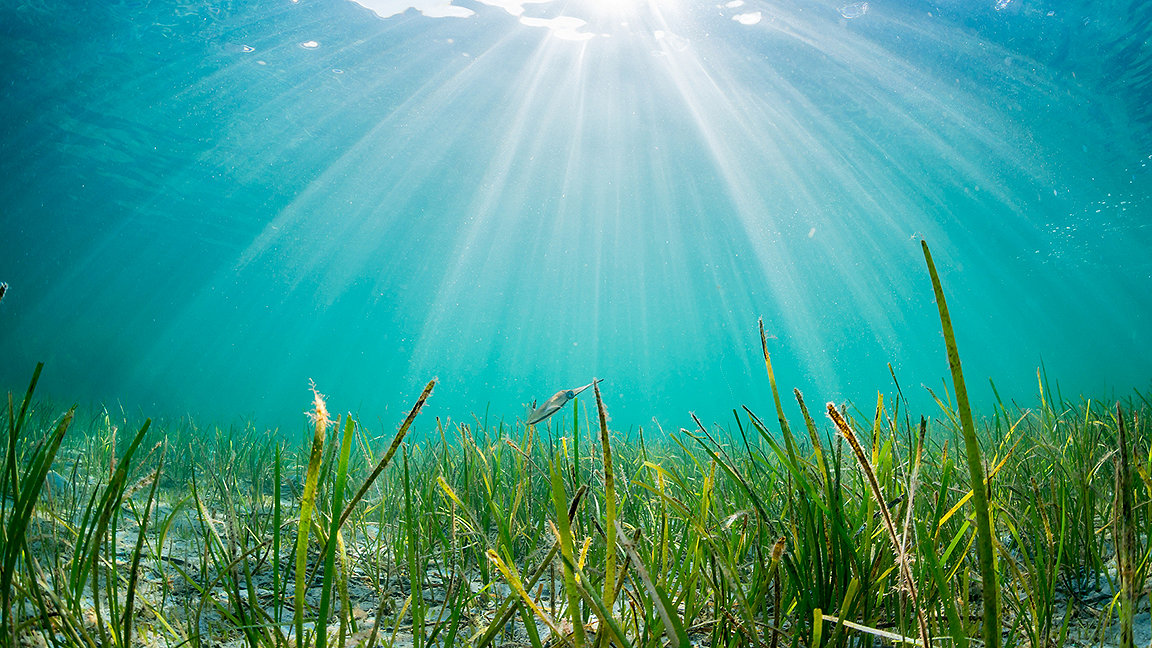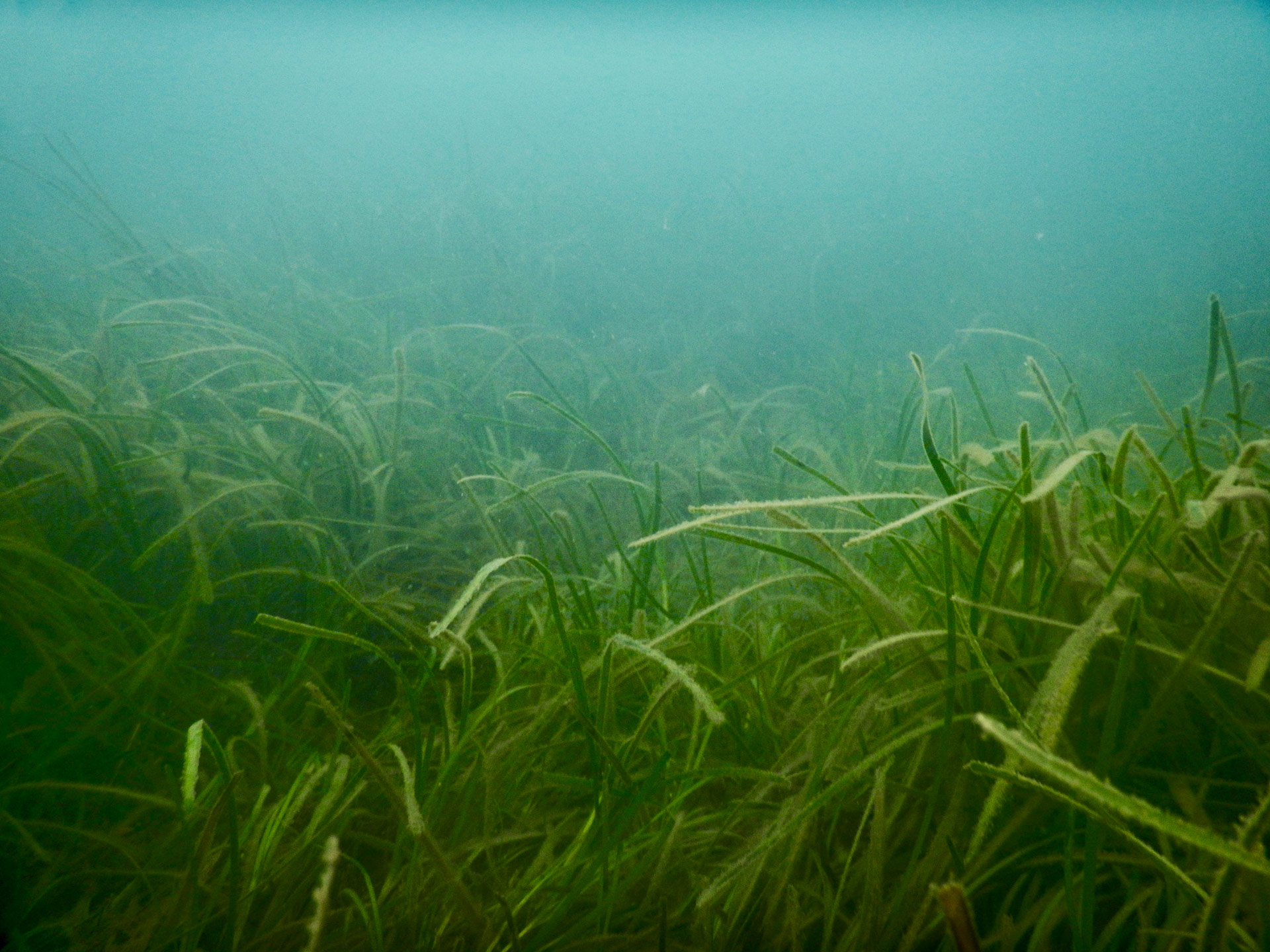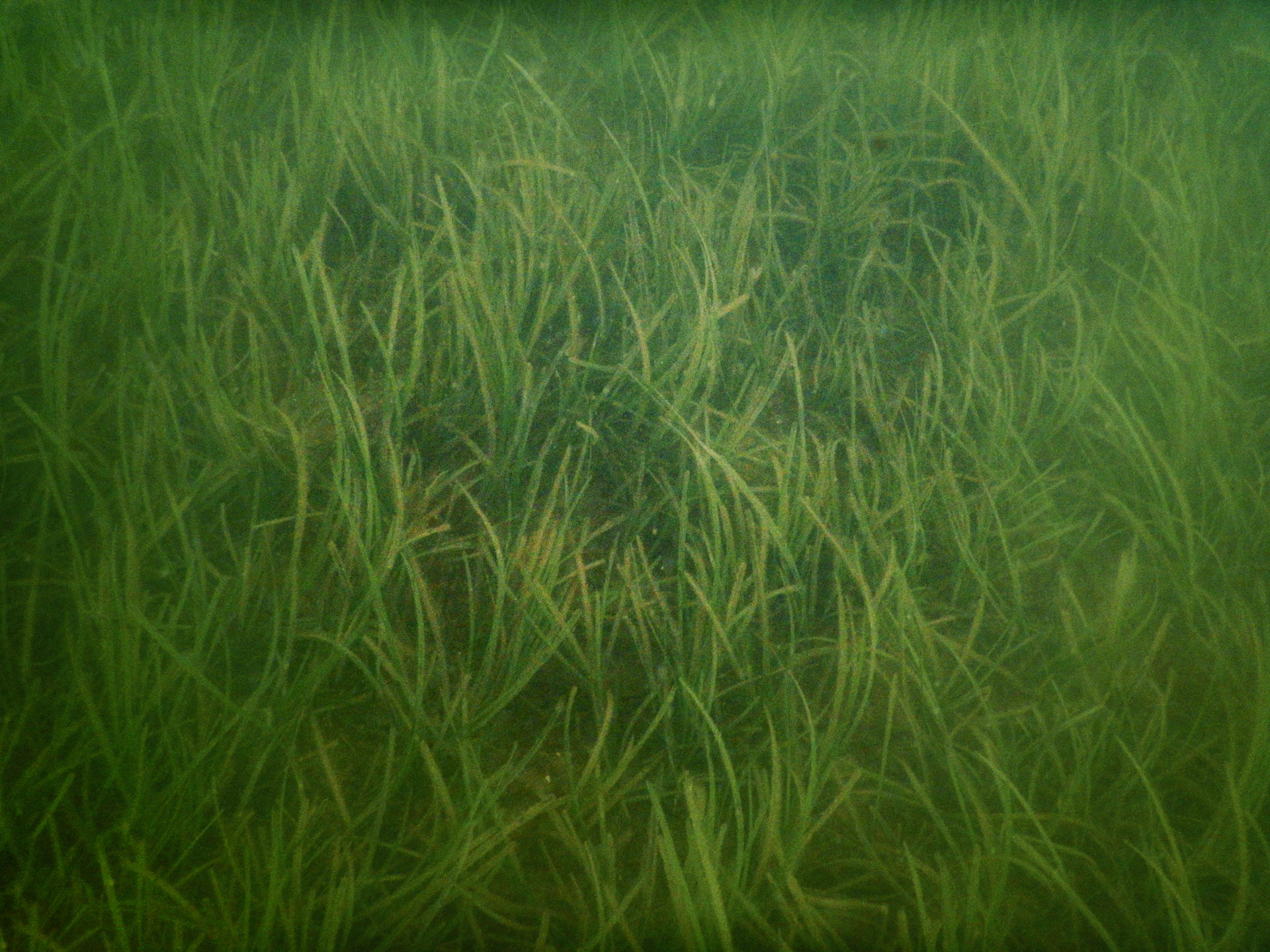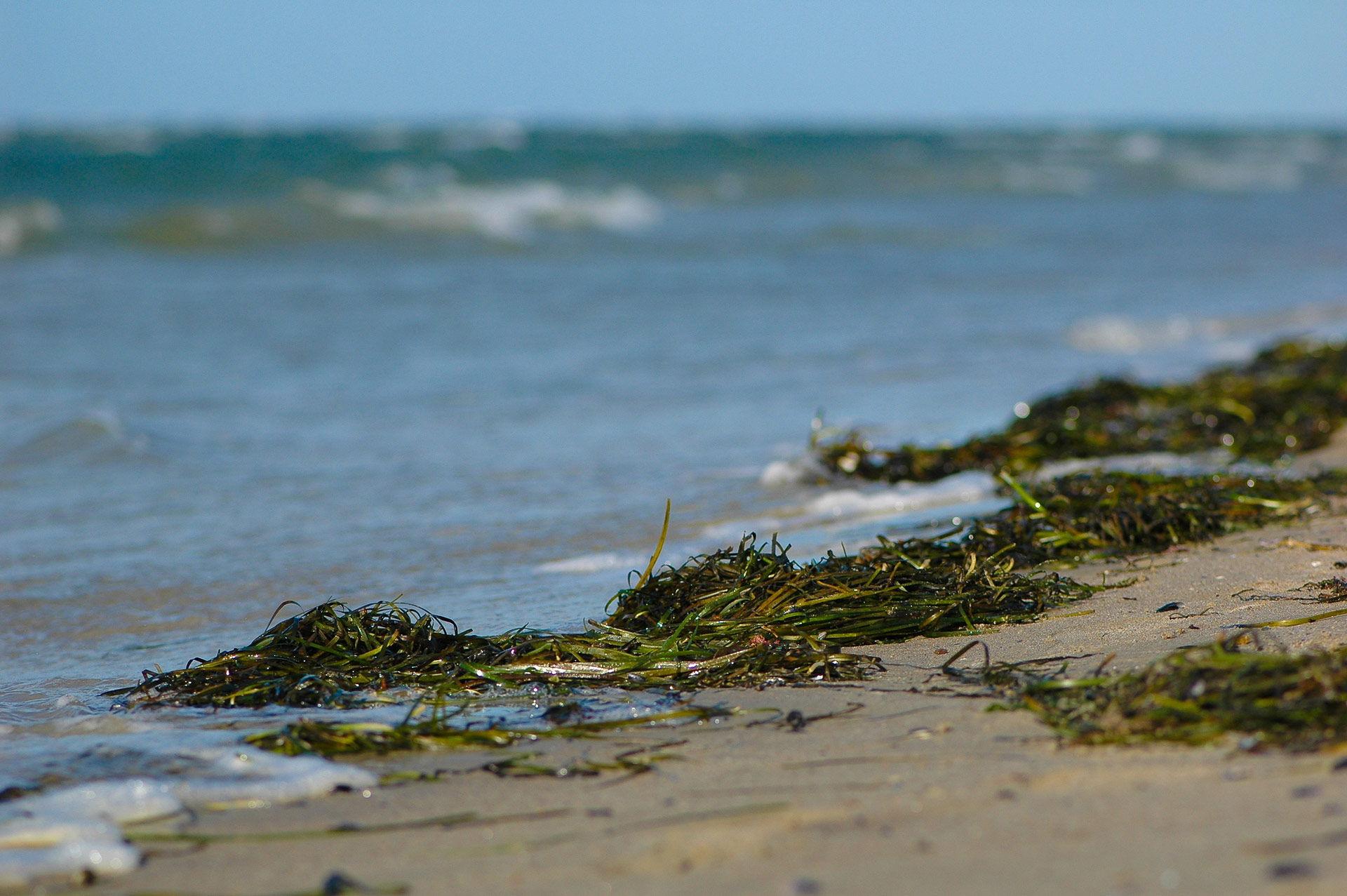
Seagrasses provide unique and valuable habitats that perform a wide range of high-value ecosystem services, despite their relatively modest global coverage. This makes them extremely valuable as a natural capital asset, and their potential environmental benefits are receiving increased attention.
But seagrasses are globally threatened, with many species declining as a result of human activities such as increased nutrient loads in coastal waters from farming and effluent outflows, as well as habitat loss from coastal development, anchoring and dredging. One of the main impacts of high nutrient loads on seagrass is the promotion of algal growth, both in the water and on the seagrass which can reduce the amount of available light. A number of projects are therefore seeking to restore the plant and ensure the habitat continues to provide vital services.
Unlike seaweeds and other algae, seagrasses are true plants with roots, leaves, flowers and seeds. They typically occupy sheltered coastal waters and can be found in subtidal zones, where they live permanently underwater, as well as intertidal zones, being covered by the water at high tide then exposed during low tides.
All 60 species of seagrass interact with their surrounding environments in a broadly similar manner, and are thus assumed to perform similar ecological functions including supporting biodiversity and species richness, as well as similar ecosystem services. Biodiversity encapsulates the variability of life at the ecosystem, species and intra-species level, whereas species richness is the measure of how many species are in a particular ecosystem.
Ecosystem services
Seagrass ecosystems can offer multiple services, for instance providing suitable habitat where commercially important fish can spawn and juveniles can shelter from predators.
In tropical countries, these ecosystems can be a source of food such as fish, shrimp, sea-cucumbers and other shellfish for coastal communities, who also use seagrass fibre in for example handcrafts, furniture, insulation and fertiliser.
Seagrass meadows help protect coasts against erosion by absorbing wave energy. Furthermore, these ecosystems have vast networks of rhizomes, specialised horizontal stems that can spread through sediment to stabilise it. The rhizome network reduces the amount of inorganic and organic particulates suspended in the water column as it is sequestered in the subsurface sediment, which improves water quality.


Blue carbon
As the ramifications of climate change are becoming better understood, so too is our appreciation of the services that natural systems perform in mitigating and adapting to its effects. Seagrasses for instance remove large quantities of carbon dioxide effectively from the atmosphere and water column through photosynthesis.
It is estimated that seagrass is responsible for storing about 10% of all oceanic carbon globally, despite covering just less than 0.1% of the sea floor. The carbon dioxide it absorbs helps fuel growth, locking it into the physical structure of the plant.
When parts of the seagrass bed age and die they are buried under a network of new roots and rhizomes, along with any trapped sediment. This is a continual process of long-term storage of organic and inorganic compounds under the healthy meadow.
The carbon stored in the plant, root structure and beneath is typically called "blue carbon". This term generally applies to a range of coastal carbon-storing ecosystems including seagrass, saltmarsh, mangroves and kelp forests.
In the UK there are only 2 species of seagrass: Zostera marina and Zostera noltii. The former typically occupies the subtidal zone, while the latter is primarily found in the intertidal zone. Combined, these seagrasses cover up to an estimated 10,000ha of the UK's total coastal waters.

Nearly all current knowledge on carbon storage by seagrasses in UK waters – and monetary estimates of the benefits provided – is based on studies of Zostera marina. In 2018 a study estimated that the current amount Zostera marina meadows store in the UK is between 108,427 and 221,870 tonnes. Based on the UK government's traded central carbon value of £24 per tonne in 2017, the monetary value of this stock would be £2.6m–£5.3m.
In comparison to Zostera marina, much less is known about the carbon sequestration potential of Zostera noltii; its contribution to ecosystem services and role of seagrasses in the intertidal zone is an emerging area of research.
"Based on the UK government's traded central carbon value of £24 per tonne in 2017, the monetary value of this stock would be £2.6m–£5.3m"
Carbon sequestration
Given the ability of UK seagrasses to sequester such vast amounts of carbon, they could directly contribute to the government's objective of achieving net-zero greenhouse gas emissions by 2050. They could also help the UK adhere to international accords such as the 2015 Paris Agreement.
However, the current estimated size of seagrass beds in the UK is only a fraction of their historic size, having declined or been lost entirely from certain regions. The rate of loss has varied over time, with an outbreak of disease in the 1920s–30s destroying more than 90% of the UK's Zostera marina beds for instance.
More recently, between 25% and 49% of total UK seagrass coverage has been lost since the 1990s, mainly due to increased nutrient loading of coastal waters. Carbon sequestered before this time may therefore have been released back into the ocean.
While these are rather alarming statistics, the water quality and conditions that enable seagrass to thrive have been improving in some estuarine areas, for example in the South West of England, in recent years, possibly as a consequence of environmental legislation such as the EU Water Framework Directive. This has led to hopes that seagrass beds may once again colonise many of the areas they historically covered, restored either by natural processes or actively with human intervention.
"Beds in sheltered, muddy bays tend to be more effective at storing carbon than those in zones subject to high levels of human disturbance"
Seagrass restoration
Seagrass beds can be restored by raising public awareness, which secures volunteers, funds and support; and through implementing specific legislation preventing their intentional destruction or removal, and safeguarding areas of known seagrass habitat. Some re-seeding and planting is helping to restore seagrass, with Dale Bay, Pembrokeshire among current projects.
Restoration initiatives may be backed by government bodies, and coastal stakeholders such as business, charities and coastal communities. While it may not be possible to return seagrass coverage to pre-1900 levels because of irreversible changes in the coastal environment – such as urban and coastal developments – restoration is still possible. But research on restoration is still a relatively new area and, though sometimes fruitful, projects are not always successful.
The benefits of restoration can be maximised by heeding existing research and encouraging further work to inform future strategy. Research is still needed to understand how seagrass ecosystems function, the services they provide, and the wider ecosystem benefits of restoration.
Restoration research
A recent study carried out in the South West of England for instance found that seagrasses in similar locations and climatic regions do not share the same potential for carbon storage. It found that local environmental characteristics have a considerable influence on the amount of carbon a particular seagrass bed can store. In particular, beds in sheltered, muddy bays tend to be more effective at storing carbon than those in zones subject to high levels of human disturbance.
- measuring the dry bulk density of seagrass
- examining whether mud and sand are clearly separated or mixed, with separated sediments generally sequestering more carbon
- looking at the overall proportion of mud in a site, as muddier sites tend to sequester more carbon.
Organisations will get a better return on their investment if they plant seagrass seeds in habitats where environmental conditions are conducive to healthy meadows that can sequester large amounts of carbon, rather than in less suitable habitats where the grass may survive but will not store so much. Scoping a suitable habitat before carrying out any physical restoration is therefore vital, especially if the goal is increased carbon sequestration.
However, it is still worth considering that planting seagrass beds in locations where they will thrive, regardless of their carbon storage potential, would still support an impressive array of ecosystem services and benefit the surrounding marine environment.
No comparative technology or human mechanism can provide an equivalent set or value of ecosystem services as seagrasses. However, care must be taken when planting new meadows and directing restoration to ensure that such efforts are optimised. Alongside this, informed regulation, increased monitoring, and continued research are fundamental to ensuring that seagrasses thrive and survive, enriching UK coastal waters.
